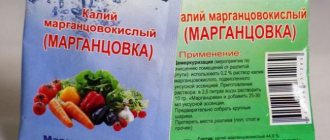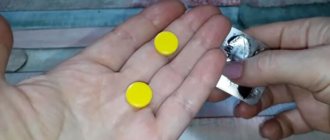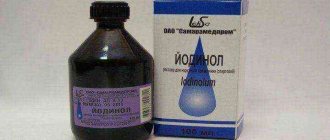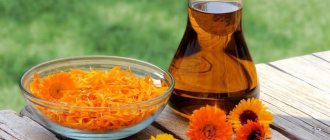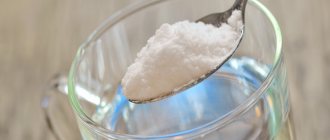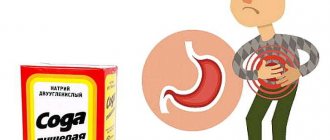Pharmacological properties of the drug Miramistin
Pharmacodynamics. The action of miramistin is based on the direct hydrophobic interaction of the molecule with the lipids of the membranes of microorganisms, leading to their fragmentation and destruction. In this case, part of the miramistin molecule, plunging into the hydrophobic portion of the membrane, destroys the supra-membrane layer, loosens the membrane, increases its permeability to high-molecular substances, changes the enzymatic activity of the microbial cell, inhibiting enzyme systems, which leads to inhibition of the vital activity of microorganisms and their cytolysis. Unlike other antiseptics, Miramistin has a highly selective action against microorganisms, since it has virtually no effect on human cell membranes. This effect is associated with a different structure of human cell membranes (much longer lipid radicals, which sharply limit the possibility of hydrophobic interaction of miramistin with cells). Miramistin has a pronounced antimicrobial effect against gram-positive and gram-negative, aerobic and anaerobic, spore-forming and asporogenic bacteria in the form of monocultures and microbial associations, including hospital strains with multidrug resistance to antibiotics. It has a detrimental effect on pathogens of sexually transmitted diseases: gonococci, Treponema pallidum, Trichomonas, chlamydia, selectively on herpes viruses. Has an antifungal effect on ascomycetes of the genus Aspergillus and genus Penicillium , yeast ( Rhodotorula rubra, Torulopsis gabrata , etc.) and yeast-like ( Candida albicans, Candida tropicalis, Candida krusei , etc.) fungi, dermatophytes ( Trichophyton rubrum, Trichophyton mentagrophytes, Trichophyton verrucosum, Trichophyton schoenleini, Trichophyton violaceum, Epidermophyton Kaufman-Wolf, Epidermophyton floccosum, Microsporum gypseum, Microsporum canis, etc.), as well as other pathogenic fungi (for example Pityrosporum orbiculare ( Malassezia furfur )) in the form of monocultures and microbial associations, including fungal microflora with resistance to chemotherapy drugs. Under the influence of miramistin, the resistance of microorganisms to antibiotics decreases. Miramistin has an anti-inflammatory and immunoadjuvant effect, enhances local protective reactions, regenerative processes, activates nonspecific defense mechanisms due to modulation of the cellular and local humoral immune response. Pharmacokinetics. When applied topically, it is not absorbed through the skin and mucous membranes.
How to dilute Miramistin for rinsing
According to the instructions, a 0.01 percent solution of Miramistin is a ready-made dosage form and does not require additional dilution.
However, judging by the reviews, the practice of using an antiseptic for rinsing has revealed some inconvenience in its use, due to the small amount specified for a single dose (less than one tablespoon).
This problem can be solved by adding the same (or half) part of clean drinking water to the required amount of medicine.
Patients with hypersensitivity who experience a slight burning sensation and discomfort when rinsing with miramistin act in a similar manner: a reduced concentration of the drug has a more gentle effect on the mucous membranes of the oral cavity and hypopharynx, maintaining the full antiseptic effect.
- Miramistin for gargling: purpose and dosage by age
For an adult
Using, according to the instructions for use, for a one-time rinse, the medicinal solution can be diluted with water in two proportions:
- 1:1;
- 2:1.
To kid
For children, reduced single doses are provided with the recommendation of diluting a 0.01 percent solution of Miramistin:
- from three to six years of age, 3-5 ml of the drug is diluted at the rate of 1:4 (for one part of the drug - 4 boiled water);
- from seven to fourteen years of age, 7 ml of antiseptic is diluted with the same amount of drinking water;
- For adolescents over 14 years of age, adult doses are recommended (10-15 ml) with optional dilutions of 1:1 or 1:0.5.
Indications for use of the drug Miramistin
surgery, traumatology: prevention of suppuration and treatment of purulent wounds: treatment of purulent-inflammatory processes of the musculoskeletal system. Obstetrics - gynecology: prevention and treatment of suppuration of postpartum injuries, wounds of the perineum and vagina; postpartum infections; inflammatory diseases of the genital organs (vulvovaginitis, endometritis). Combustiology: treatment of superficial and deep burns of II–IIIA degrees, preparation of burn wounds for autodermoplasty. Dermatology, venereology: treatment of candidiasis of the skin and mucous membranes, mycoses of the feet and large folds; prevention of sexually transmitted diseases (syphilis, gonorrhea, genital herpes, genital candidiasis). Urology: complex treatment of acute and chronic urethritis and urethroprostatitis of specific (chlamydia, trichomoniasis, gonorrhea) and nonspecific nature. Dentistry: treatment of periodontitis, stomatitis, hygienic treatment of removable dentures. Otolaryngology: complex treatment of acute and chronic otitis, sinusitis, tonsillitis, laryngitis.
How long can it take to process?
When removing a tooth, the dentist must treat the wound, remove any remaining pus, and tooth fragments. But it does not stop the bleeding. A dense blood clot forms at that site, which acts as a plug, thereby clogging the wound. It protects it from food, moisture, and those same bacteria.
But until that clot “hardens” completely, no manipulations with the wound can be carried out. Any lotions, compresses, or rinses will cause the blood clot to simply become limp and “fall out” of the wound.
How long does it take for the clot to “freeze”? On average - 24-36 hours. During this period, you should eat with caution, brush your teeth (without running a toothbrush over the wound), avoid hot foods (this even applies to baths or showers) and smoking.
It is possible to treat the area where the diseased tooth was previously located only after 36-48 hours. Moreover, it is better to start with ordinary cotton compresses. When rinsing the mouth, there is a high probability that the blood clot will “come out”.
After tooth extraction, the doctor will definitely tell you what the patient should do afterwards. First of all, it is necessary to focus on his instructions, since he assesses both the patient’s condition and the likelihood of damage to the jaw bone. If necessary, he will prescribe an antibiotic and painkiller, and set a day for a re-examination.
Use of the drug Miramistin
Locally. Surgery, traumatology, combustiology. For preventive and therapeutic purposes, miramistin is used to irrigate the surface of wounds and burns, loosely pack wounds and fistula tracts, and fix gauze swabs moistened with an antiseptic. The treatment procedure is repeated 2–3 times a day for 3–5 days. The method of active drainage of wounds and cavities with a daily consumption of about 1 liter of the drug is highly effective. Obstetrics - gynecology . In order to prevent postpartum infection, 50 ml of the drug is used in the form of vaginal tampons with an exposure of 2 hours for 5 days in the form of vaginal irrigations before childbirth (5–7 days), during childbirth after each vaginal examination and in the postpartum period. When delivering by caesarean section, the vagina is treated immediately before the operation, during the operation - the uterine cavity and the incision on it, and in the postoperative period, tampons moistened with 50 ml of solution are inserted into the vagina with an exposure of 2 hours for 7 days. Treatment of inflammatory diseases of the female genital organs is carried out by intravaginal administration of tampons with the drug for 2 weeks, as well as administration of the drug by electrophoresis. Venereology . For the prevention of sexually transmitted diseases, Miramistin is effective if it is used no later than 2 hours after sexual intercourse. Using the nozzle, insert the contents of the bottle into the urethra of men (2–3 ml), women (1–2 ml), into the vagina (5–10 ml) and into the urethra (1–2 ml) for 2–3 minutes. The skin of the inner thighs, pubis, and genitals is treated. Urology. In the complex treatment of urethritis and ureoprostatitis by endourethral instillation of 2–3 ml of 0.01% miramistin solution 1–2 times a day, course - 10 days. The procedure is repeated every other day. Otorhinolaryngology . In the complex treatment of purulent sinusitis, during puncture the maxillary sinus is washed with a sufficient amount of antiseptic. In the treatment of tonsillitis and laryngitis, repeated gargling with a solution of the drug is carried out. Dentistry . Treatment of periodontitis by introducing turundas moistened with miramistin solution into periodontal pockets, followed by applications to the gums for 15 minutes. During exacerbations, rinsing periodontal pockets with Miramistin using a syringe and introducing turundas moistened with the drug into the abscess cavity are used. After vestibuloplasty and frenulectomy, Miramistin is used in the form of baths on an outpatient basis. Miramistin is used for medicinal treatment of carious cavities, tooth canals after pulp extraction, and hygienic treatment of removable dentures.
Brief characteristics of the drug
Miramistin is an antiseptic intended for topical use. The drug has no color or foreign odors. The main active ingredient of the drug affects the cellular structure of microbes and destroys them. Miramistin effectively fights the following types of bacteria:
- staphylococci,
- streptococci,
- gram-negative bacteria,
- anaerobic and aerobic,
- immunodeficiency viruses,
- fungal infection pathogens.
The drug is available in the form of ointment, spray and solution. Use the solution to gargle. With this remedy you can reduce swelling and inflammation in the throat, prevent purulent formations and complications. The medicine promotes rapid healing of wounds. Miramistin will also help cope with stomatitis, herpes, and caries.
Miramistin, as a rule, does not cause allergic reactions. Very rarely, the patient experiences a burning sensation in the treated area. This is possible with individual intolerance. The medicine is approved for use by children from three years of age, pregnant and lactating women.
Special instructions for the use of the drug Miramistin
The drug does not have a local irritant effect and does not have allergenic properties. Venereology. Urology. After treating the urethra, vagina, inner thighs, pubis and genitals with miramistin, it is not recommended to urinate for 2 hours. Use during pregnancy and lactation. Since drug resorption is almost completely absent, Miramistin can be used during pregnancy and lactation. The ability to influence the reaction rate when driving a vehicle or working with other mechanisms. During treatment with the drug, it is possible to drive vehicles and engage in other potentially hazardous activities that require increased concentration and speed of psychomotor reactions.
How to gargle correctly with Miramistin: instructions
The antiseptic agent Miramistin has a wide spectrum of action and is used not only in otolaryngology. This rinse should be used strictly in accordance with the instructions. For ease of handling, bottles with Miramistin for gargling are equipped with a special nozzle with a sprayer, which allows you to inject the required amount of the substance directly onto the pharyngeal mucosa.
Miramistin: how to gargle for an adult
In order for the use of the solution to give the desired result, it is worth familiarizing yourself in advance with how to gargle with Miramistin. The annotation for the drug states that Miramistin solution 0.01% is a ready-to-use product.
The recommended amount of Miramistin for gargling per procedure is 10-15 ml (about 1 tablespoon), which most often causes confusion among patients - how can an adult gargle with such a small amount of Miramistin? Otolaryngologists say that this is quite enough if you first rinse your throat with a herbal decoction or warm water and then gargle with Miramistin.
The procedure must be carried out after a meal, after quenching your thirst so that you don’t want to eat or drink anything in the next half hour. The number of procedures per day is at least 3-4 times, the duration of treatment is no more than 10 days. The instructions for use state that if you are hypersensitive to the drug Miramistin, gargling is contraindicated.
How to gargle with Miramistin for a child
Can children use Miramistin to gargle: the instructions allow the use of this antiseptic from 3 years of age. But in order for this procedure to have a therapeutic effect, it is necessary to teach the child to gargle much earlier.
Dentists advise teaching children to brush their teeth from the age of 2; around this age it is worth starting to gargle with warm water.
First, have your baby throw back his head and try to make a long “x” sound. Then you should do the same by taking some water into your mouth. Be sure to teach your baby not to swallow, but to spit out the rinse. If a small child does not yet have these skills, you should not immediately arrange for him to gargle with Miramistin.
Despite minimal side effects and contraindications, this medicine is intended for topical use only and should not enter the digestive tract. In addition, small children need to dilute the pharmaceutical solution with water.
A little later we will tell you how to dilute Miramistin for gargling for a child. As an alternative, you can use a rinse with a spray bottle to irrigate your child's infected mucous membranes.
Miramistin - gargling during pregnancy
To rinse the sore throat or tonsils in pregnant women, it is also preferable to use a rinse with a spray. This device will allow you to avoid such an undesirable reaction as nausea, which is typical for pregnant women and can intensify during the gargling procedure. Basic requirements for the use of such a throat treatment:
- carrying out manipulations after eating;
- preliminary cleaning of infected mucus (you can gargle with warm water and salt or spray it with Aqualor spray);
- compliance with the doses recommended by the instructions - 2-4 injections at a time;
- compliance with the frequency of procedures - 3-5 rinses (or injections) per day.
How to gargle with Miramistin without a spray was described in previous sections.
- Miramistin for the treatment of throat: how to use correctly
